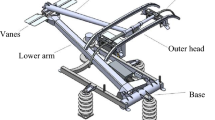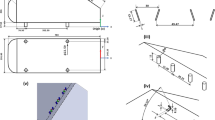Abstract
Upon the entrance of a high-speed train into a relatively long train tunnel, compression waves are generated in front of the train. These compression waves subsequently coalesce into a weak shock wave so that a unpleasant sonic boom is emitted from the tunnel exit. In order to investigate the generation of the weak shock wave in train tunnels and the emission of the resulting sonic boom from the train tunnel exit and to search for methods for the reduction of these sonic booms, a 1∶300 scaled train tunnel simulator was constructed and simulation experiments were carried out using this facility.
In the train tunnel simulator, an 18 mm dia. and 200 mm long plastic piston moves along a 40 mm dia. and 25 m long test section with speed ranging from 60 to 100 m/s. The tunnel simulator was tilted 8° to the floor so that the attenuation of the piston speed was not more than 10 % of its entrance speed. Pressure measurements along the tunnel simulator and holographic interferometric optical flow visualization of weak shock waves in the tunnel simulator clearly showed that compression waves, with propagation, coalesced into a weak shock wave. Although, for reduction of the sonic boom in prototype train tunnels, the installation of a hood at the entrance of the tunnels was known to be useful for their suppression, this effect was confirmed in the present experiment and found to be effective particularly for low piston speeds. The installation of a partially perforated wall at the exit of the tunnel simulator was found to smear pressure gradients at the shock. This effect is significant for higher piston speeds. Throughout the series of train tunnel simulator experiments, the combination of both the entrance hood and the perforated wall significantly reduces shock overpressures for piston speeds ofu p ranging from 60 to 100 m/s. These experimental findings were then applied to a real train tunnel and good agreement was obtained between the tunnel simulator result and the real tunnel measurements.
Similar content being viewed by others
References
Aoki T, Kashimura H, Nonaka Y, Matsuo K (1992) Discharge of a compression wave from an open end of a tube. In: Takayama K (ed) Shock Waves, Proc. of the 18th Intl. Symp. on Shock Waves. Springer-Verlag, Heidelberg, pp 1331–1334
Blake WK (1986) Mechanics of flow-induced sound and vibration, vol. 1. Academic Press, p 204
Deckker BEL, Koyama H (1983) Motion of a weak shock wave in a porous tube. In: Archer, Milton (eds) Proc. 14th Intl. Symp. Shock Tubes Waves, Sydney pp 239–246
Iida M (1993) Numerical studies of compression waves generated by train entering tunnels. Ph.D thesis, Univ. Tokyo
Kasimura H, Yasunobu T, Aoki T, Matsuo K (1994) Emission of a propagating compression wave from an open end of a tube (2nd Report, relation between incident compression wave and impulsive wave). Tran. Jpn Soc. Mech. Engineers (in Japanese) B60:71
Lukasiewicz J (1976) Rail way game. Carlton Contemporary
Matsuo K, Aoki T (1992) Wave problems in high-speed railway tunnels. In: Takayama K (ed) Shock Waves, Proc. of the 18th. Intl. Symp. on Shock Waves. Springer-Verlag, Heidelberg, pp 95–102
Onodera H, Takayama K (1990) Shock wave reflection over wedges with suction. Tran. Jpn Soc. Mech. Engineers (in Japanese) B56:112
Onodera H, Takayama K (1992) An analysis of shock wave propagation over perforated wall and its discharge coefficient. Tran. Jpn Soc. Mech. Engineers (in Japanese) B58:1408
Ozawa S, Moritoh Y, Maeda T, Kinoishita M (1976) Investigation of pressure wave radiated from a tunnel exit (in Japanese). Railway Tech Res Rep, The Railway Tech Res Inst, Japan Nat Railways 1023
Ozawa S (1979) Studies of micro-pressure wave radiated from a tunnel exit. Railway Tech Res Rep, The Railway Tech Res Inst, Japan Nat Railways 1121
Rudinger G (1957) The reflection of pressure waves of finite amplitude from an open end of a duct. J. Fluid Mech. 3:48
Sajben M (1971) Fluid Mechanics of train-tunnel systems in unsteady motion. AIAA J 9:1538–1545
Sasoh A, Onodera O, Takayama K, Kaneko R, Matsui H (1994a) Experimental study of shock wave generation by high speed train entrance in to a tunnel (in Japanese). Trans Jpn Soc Mech Engineers, in press
Sasoh A, Onodera O, Takayama K (1994b) Scaled train-tunnel simulator for weak shock wave generation experiment. Rev. Sci. Instrum. 65:3000
Sasoh A, Funabashi S, Saito T, Takayama K (1994c) A numerical and experimental study of sonic boom generated from high speed train tunnels. In: Proc of the 19th Int Symp on Shock Waves. Springer-Verlag, Heidelberg, in press
Sasoh A, Onodera O, Takayama K, Kaneko R, Matsui H (1994d) Experimental investigation of the reduction of railway tunnel sonic boom (in Japanese). Trans Jpn Soc Mech Engineers, submitted
Shapiro AH (1983) The Dynamics and Thermodynamics of Compressible Fluid Flow, vol. 2. Robert E Krieger Publ, Reprint Edition
Stollery JL, Phan KC, Garry KP (1981) Simulation of blast waves by hydraulic analogy. In: Treanor CE, Hall JG (eds) Shock Tubes and Waves, Proc. 13th Intl. Symp., pp 781–786
Szumowski AP (1971) Attenuation of a shock wave along a perforated tube. In: Stollery JL, Gaydon AG, Wen PR (eds) Shock Tube Research, Proc. 8th Int. Symp. Shock Tubes. Chapman & Hall 14
Takayama K, Saito T, Sasoh A, Onodera O, Funabashi S, Kaneko R, Matsui Y (1993) A numerical and experimental study of sonic boom generated from high speed train tunnels. Int Conf on Speedup Technology for Railway and Maglev Vehicles, Nov. Yokohama pp 305–310
Wu JHT, Ostrowski PP (1971) Shock attenuation in a perforated duct. In: Stollery JL, Gaydon AG, Wen PR (eds) Shock Tube Research, Proc. 8th Int. Symp. on Shock Tubes. Chapman & Hall 15
Author information
Authors and Affiliations
Rights and permissions
About this article
Cite this article
Takayama, K., Sasoh, A., Onodera, O. et al. Experimental investigation on tunnel sonic boom. Shock Waves 5, 127–138 (1995). https://doi.org/10.1007/BF01435520
Received:
Accepted:
Issue Date:
DOI: https://doi.org/10.1007/BF01435520




